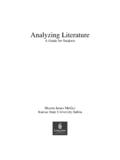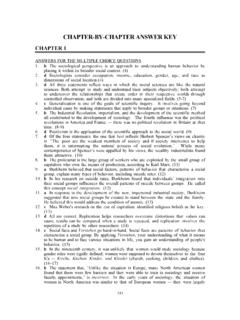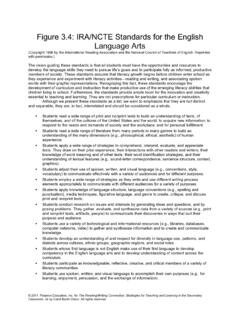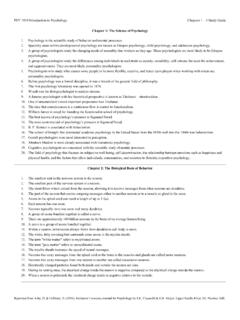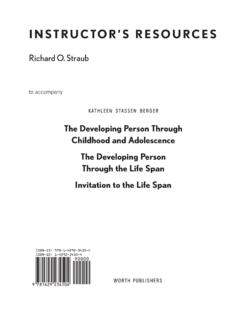Transcription of The Allyn and Bacon Guide to Writing - wps.ablongman.com
1 instructor S resource MANUALto accompanyRamage/Bean/JohnsonThe Allyn and Bacon Guide to WritingThird Edition,Brief Edition,andConcise EditionwithThe WPA Outcomes Statement for First-Year HarringtonIndiana University Purdue University IndianapolisNew York Boston San FranciscoLondon Toronto Sydney Tokyo Singapore MadridMexico City Munich Paris Cape Town Hong Kong MontrealNOTE REGARDING WEB SITES AND PASSWORDS:If you need a password to access instructor supplements on a Longmanbook-specific Web site, please use the following information:Username: awlbookPassword: adoptInstructor's resource Manual to accompany Ramage/Bean/Johnson, The Allyn andBacon Guide to Writing , Third Edition, Brief Edition and Concise Edition, with The WPAO utcomes Statements for First-year CompositionCopyright 2003 Pearson Education, rights reserved. Printed in the United States of America. Instructors may reproduceportions of this book for classroom use only.
2 All other reproductions are strictlyprohibited without prior permission of the publisher, except in the case of brief quotationsembodied in critical articles and : WPA Outcomes Statement for First-Year Composition. WPA: Writing ProgramAdministration Volume (Fall/Winter 1999): 59-63, Used by : 0-321-10892-21 2 3 4 5 6 7 8 9 10 DPC 05 04 03 02 Table of ContentsPrefaceGetting StartedGeneral Teaching Strategies1 Suggested Syllabi for The Allyn and Bacon Guide to Writing34 Chapter GuidesChapter 1 Posing Problems: The Demands of College Writing39 Chapter 2 Pursuing Problems: Exploratory Writing and Talking 47 Chapter 3 Thinking Rhetorically About Question,54 Thesis and SupportChapter 4 Thinking Rhetorically About Purpose,61 Audience and GenreChapter 5 Seeing Rhetorically: The Writer as Observer68 Chapter 6 Reading Rhetorically: The Writer as Strong Reader79 Chapter 7 Writing an Autobiographical Narrative89 Chapter 8 Writing an Exploratory Essay102 Chapter 9 Writing an Informative (and Surprising)
3 Essay111 Chapter 10 Analyzing Images120 Chapter 11 Analyzing Numerical Data128 Chapter 12 Analyzing a Short Story139 Chapter 13 Analyzing and Synthesizing Ideas148 Chapter 14 Investigating Cause and Consequence156 Chapter 15 Writing a Classical Argument165 Chapter 16 Making an Evaluation181 Chapter 17 Proposing a Solution188 Chapter 18 Writing as a Problem-Solving Process196 Chapter 19 Composing and Revising Closed-Form Prose204 Chapter 20 Composing and Revising Open-Form Prose213 Chapter 21 An Introduction to Research212 Chapter 22 Finding and Evaluating Sources221 Chapter 23 Using, Citing, and Documenting Sources230 Chapter 24 Advanced or Specialized Research Skills226 Chapter 25 Oral Communication: Working in Groups237and Giving SpeechesChapter 26 Essay Exams: Writing Well Under Pressure248 Chapter 27 Assembling a Portfolio and Writing Reflective253 Self-EvaluationsAnswers to Handbook Exercises257 Specialized InstructionUsing The Allyn and Bacon Guide to Writing with 263 Non-Native Speakers of EnglishUsing The Allyn and Bacon Guide to Writing in an 277 Electronic ClassroomThe Allyn and Bacon Guide to Writing and the 291 WPA Outcomes StatementPrefaceThe earlier editions of this instructor s resource manual were enthusiastically receivedby both experienced and novice teachers, who praised the manual s thoroughness andhelpful advice.
4 In this third edition, the strengths of the earlier editions have been retained,while the contents have been revised and updated in accordance with the changes andimprovements made in the third edition of The Allyn and Bacon Guide to Writing . Mostnotably, discussions are included for all new readings, material has been added to supportthe text s new emphasis on analyzing visual rhetoric, all chapters are expanded in keepingwith similar revisions in the textbook, and new chapters are included to accompany thetext s new chapters on analysis and synthesis and oral presentations. In addition, themanual s chapters on teaching research have been redesigned in light of the extensivechanges in Part 4 of The Allyn and Bacon Guide to Writing . If you are familiar with theearlier edition of this instructor s resource manual, you will also note that even in placeswhere the textbook remained unchanged, the manual has been revised for improved clarityand manual begins with General Teaching Strategies, a review of practicalsuggestions presented in a question-and-answer format.
5 If you would like even moresupplementary guidance of this nature, contact Allyn and Bacon for a complimentary copyof The Allyn and Bacon Sourcebook for College Writing Teachers by James C. McDonald(a collection of scholarship on composition theory and pedagogy), Teaching CollegeWriting by Maggy Smith (practical tips especially helpful for new Writing teachers), AnIntroduction to Teaching Composition in an Electronic Environment by Eric Hoffman andCarol Scheidenhelm, and In Our Own Voice: Graduate Students Teach Writing , by TinaLavonne Good and Leanne B. major sections of the manual you may want to read carefully offer advice forplanning a syllabus based on The Allyn and Bacon Guide to Writing and using the textbookwith non-native speakers and/or in an electronic classroom. The manual also containsanswers to the handbook exercises found in the full last chapter in this manual highlights the ways in which The Allyn and BaconGuide to Writing s approach offers many opportunities for students to work in each of thefour domains outlined in The Council of Writing Program Administrators OutcomesStatement.
6 The remaining chapters in this manual, numbered to correspond with the chapters inThe Allyn and Bacon Guide to Writing (3rd edition), each contain these sections: Understanding the Chapter s Goals ; Reinforcing the Chapter s Rhetorical Principles ; Using the For Writing and Discussion Activities ; and Guiding Students through theWriting Project. Chapters 5 through 16, devoted to the Writing projects, also include Discussing the Readings. You will find the manual most helpful if you at least skim thechapter in the textbook first. Together, the textbook and the manual will give you amplemethods to engage your students in the vital study of am greatly indebted to my colleagues at Indiana University Purdue UniversityIndianapolis, whose ingenuity and creativity show me new approaches to teaching writingwith every hallway conversation and formal workshop or meeting. I am a better teacher andadministrator because of them.
7 Any errors or infelicities here are of my own creation. I am also grateful to Vicki Byard of Northeastern Illinois University. She wrote thefirst two editions of this resource manual. Her excellent work forms the foundation of Teaching StrategiesOverviewIn this opening section of the instructor s manual, you will find many practicalsuggestions to help you accomplish your responsibilities as a Writing teacher. If you are ateaching assistant or beginning instructor , you may want to read this section now andreview it again as the course progresses. Even if you are a more experienced teacher, youare still likely to find ideas in this section that can enhance your expertise; scan the headingsfor concerns which especially interest you. The teaching concerns addressed are these: Preparing for the First Day of Class Designing Lesson Plans Fostering Student Participation Asking Questions Discussing Readings Explaining In-Class Activities Assigning Homework Facilitating Peer Review Workshops on Drafts Conferencing with Students Managing Journals and Portfolios Grading Keeping Records Handling Difficult Situations and Students Seeking Feedback to Improve Your Teaching Reading More about Teaching StrategiesBeneath each heading, the teaching strategies are presented in a question-answer formatto help you quickly identify your concerns and find workable solutions.
8 Four additional texts are available from Allyn & Bacon to supplement this discussionof general teaching strategies: The Allyn & Bacon Sourcebook for College Writing Teachersby James C. McDonald, Teaching College Writing by Maggy Smith, and An Introduction toTeaching Composition in an Electronic Environment by Eric Hoffman and CarolScheidenhelm, and In Our Own Voice: Graduate Students Teach Writing by Tina LavonneGood and Leanne B. Warshauer. All of these texts are described in the annotatedbibliography that appears at the end of this chapter. Contact your Allyn & Baconrepresentative if you would like complimentary copies of one or more of these texts. Youmay also wish to access the Allyn & Bacon CompSite Web Page for additional resources at2 for the First Day of ClassWhat handouts should I prepare for the first class?The most important document is the syllabus. It s the first formal presentation of thecourse, and it gives students an idea of your goals and teaching style as well as key coursepolicies.
9 On pages 33-37 of this instructor s manual, there are suggestions for designingsyllabi for quarter-length and semester-length Writing courses that use The Allyn and BaconGuide to Writing . In addition to a description of the course goals, overview of majorassignments, grading policies, and a review of any prerequisites, the syllabus should offer adaily or weekly schedule of requirements and activities. Even if you plan to distribute amore detailed schedule as the course moves ahead, use the initial syllabus to show studentsmajor deadlines, approximate reading and Writing homework expectations, and examples ofregular in-class activities. The syllabus should also provide contact information: when andwhere students can reach you (your office location and hours, your office phone number,fax number if you use it, and your e-mail address). The syllabus should also communicateyour expectations for students behavior (what kinds of participation you expect, whatpenalties may be imposed for absence or late work, for example), as well as what studentsmay expect from you (how quickly do you respond to essays, for example).
10 If you havefirm preferences for the format of assignments, outline those on the syllabus, even if theywill be repeated on individual assignment sheets. Tell students up front whether youaccept handwritten essays, require that planning work be turned in with the final version,prefer particular margin settings, or have opinions about the uses of staples, paper clips, document many teachers like to distribute on the first day is a questionnairethat asks students information about themselves. You may want to know how you cancontact them if necessary outside class time (address, home and work phone numbers, e-mail address), their year in school, their academic advisor, their major(s) and possibleminor(s), their prior Writing experience, other responsibilities at home or work that maylimit the time they can devote to your course, and any special concerns they may haveabout this course. While some teachers ask students to write basic contact information onindex cards or ask students to answer these questions on their own paper, others prefer aquestionnaire so that students can complete the form at home and return it when the classnext meets.
